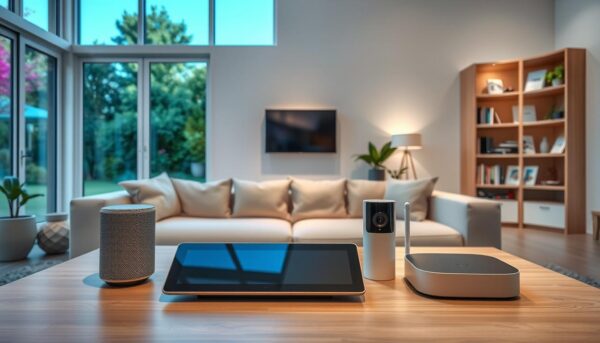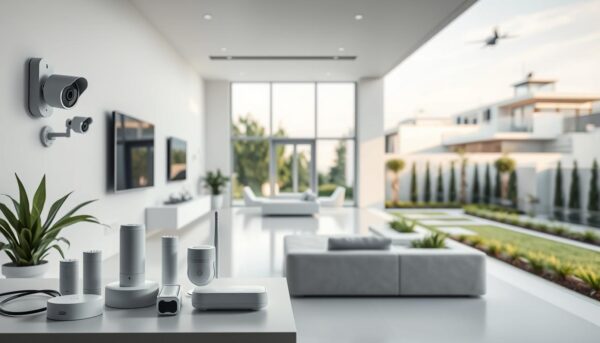✅ Last checked on
Imagine this: you’re halfway through adjusting your thermostat or locking your doors when suddenly, your connection drops. What happens to your automated routines then? The answer depends on whether your setup relies on cloud processing or runs independently through your own network.
Modern homes increasingly depend on interconnected devices that communicate seamlessly. Popular platforms like Apple HomeKit and Amazon Alexa use cloud servers to manage commands. While convenient, this approach leaves you vulnerable during outages—your lights, locks, or cameras might become unresponsive.
Alternative setups process data directly through a central hub in your house. These systems don’t need external servers, meaning they work even without Wi-Fi. Response times are faster, and sensitive information stays within your walls. But how do these approaches differ in protecting your privacy or maintaining reliability?
Choosing between these models affects everything from daily convenience to long-term security. For example, a well-integrated system ensures devices collaborate smoothly, whether they’re cloud-linked or locally managed. The right balance depends on your priorities: instant access from anywhere versus uninterrupted control at home.
Key Takeaways
- Cloud-based platforms require internet access for most functions, creating potential downtime during outages.
- Locally processed systems operate independently, offering consistent performance without external servers.
- Data privacy improves when information stays within your home network instead of traveling to the cloud.
- Central hubs act as translators, allowing diverse devices to work together in automated routines.
- Response speeds often increase with local processing due to reduced reliance on distant servers.
Overview of Smart Home Automation and Systems
Your connected ecosystem thrives on how gadgets “talk” to each other. Whether adjusting lights or managing entry points, these interactions rely on three pathways: wired cables, wireless protocols like Zigbee, and internet-dependent platforms. Each method shapes performance and flexibility.
Defining Smart Home Systems and Their Communication Methods
At its core, a unified setup links thermostats, locks, and sensors through a central hub. This brain translates commands between devices using different languages. For instance, Philips Hue lights use Zigbee to communicate locally, while Ring cameras require Wi-Fi for cloud processing.

Understanding the Basics of Local and Cloud Integration
Cloud-dependent platforms let you adjust settings from anywhere via apps. “The convenience of remote access comes with a trade-off,” notes a smart home comparison guide. If storms knock out your internet, cloud-linked gadgets may freeze. Local setups avoid this by processing data through your hub—no external servers needed.
Hybrid approaches are emerging too. Some systems use Bluetooth for immediate responses but sync logs to the cloud later. This balance maintains functionality during outages while preserving access to historical data.
Evaluating Privacy, Stability, and Speed in Home Automation
What happens when your front door unlocks before you reach the handle? This seamless experience depends on how your setup handles sensitive information and technical hiccups. Two critical factors separate reliable automation from frustrating glitches: where data travels and how quickly it arrives.
Privacy and Security Considerations in Cloud-Based Systems
Service providers often store your activity logs on remote servers. A 2022 Consumer Reports study found 78% of connected platforms share anonymized usage patterns with third parties. While companies claim this improves services, it creates attack vectors for hackers. Imagine your lighting schedule leaking through a breached vendor API—this risk grows with every cloud-dependent gadget.

Stability and Speed Benefits of Direct Processing
Systems using in-house hubs eliminate internet bottlenecks. Your commands execute in milliseconds since they don’t route through distant data centers. During a storm-induced outage, you’ll still adjust thermostats or view camera feeds. One user reported their lights responded 40% faster after switching to a self-contained setup.
Latency differences become obvious in multi-device routines. Cloud-reliant setups might delay unlocking doors until motion sensors confirm your arrival. Direct processing handles these triggers simultaneously through your hub. You gain reliability without sacrificing responsiveness—even during peak network traffic.
Local vs Cloud Smart Home: Making the Right Choice
Choosing how your gadgets operate impacts daily convenience and long-term reliability. While some prioritize instant adjustments from their phones, others value consistent performance during storms or outages. Let’s break down what works best for different lifestyles.
Local Control Advantages and Setup Considerations
Systems processing commands through a central hub excel in speed and stability. Konnected’s alarm upgrade kits, for example, work offline by connecting sensors directly to your network. You’ll avoid delays caused by distant servers—lights respond instantly, and locks engage without lag.
Installation often requires technical know-how. Wiring sensors or configuring a hub might need professional help. But once running, these setups rarely fail, even during internet blackouts. Compatibility varies though—older devices may need adapters to communicate with modern hubs.
Cloud Automation Benefits, Challenges, and Cost Implications
Cloud platforms shine in simplicity. The Tedee smart lock illustrates this: pair it with Wi-Fi, and you’re done. Renters appreciate no-wiring solutions, while frequent travelers enjoy remote access via apps.
Monthly fees add up over time, though. Service outages could lock you out temporarily, and data breaches remain a concern. Still, cloud systems evolve faster—new features arrive automatically without hardware swaps.
Conclusion
Your ideal setup balances immediate needs with future-proof reliability. Systems handling commands through a hub excel in responsiveness, executing routines without delays caused by shaky internet links. Processing data within your walls keeps information secure while maintaining lights, locks, and thermostats during outages.
Cloud-connected platforms offer unmatched convenience for remote adjustments. However, third-party servers storing activity logs introduce potential vulnerabilities. Regular service fees and reliance on corporate infrastructure add long-term considerations beyond initial setup costs.
Prioritize privacy by reviewing how companies handle usage data. Test different products through trials or consultations with certified installers. Whether you value self-contained operations or seamless app access, aligning choices with daily habits ensures lasting satisfaction.
There’s no universal solution—assess your budget, technical confidence, and how deeply you want gadgets integrated into daily living. Both approaches deliver distinct advantages when matched to the right household.